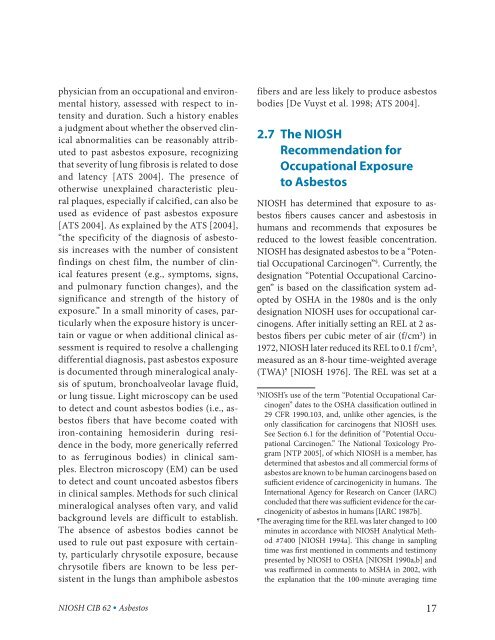Asbestos Fibers and Other Elongate Mineral Particles: State of the ...
Asbestos Fibers and Other Elongate Mineral Particles: State of the ...
Asbestos Fibers and Other Elongate Mineral Particles: State of the ...
- No tags were found...
You also want an ePaper? Increase the reach of your titles
YUMPU automatically turns print PDFs into web optimized ePapers that Google loves.
physician from an occupational <strong>and</strong> environmental<br />
history, assessed with respect to intensity<br />
<strong>and</strong> duration. Such a history enables<br />
a judgment about whe<strong>the</strong>r <strong>the</strong> observed clinical<br />
abnormalities can be reasonably attributed<br />
to past asbestos exposure, recognizing<br />
that severity <strong>of</strong> lung fibrosis is related to dose<br />
<strong>and</strong> latency [ATS 2004]. The presence <strong>of</strong><br />
o<strong>the</strong>rwise unexplained characteristic pleural<br />
plaques, especially if calcified, can also be<br />
used as evidence <strong>of</strong> past asbestos exposure<br />
[ATS 2004]. As explained by <strong>the</strong> ATS [2004],<br />
“<strong>the</strong> specificity <strong>of</strong> <strong>the</strong> diagnosis <strong>of</strong> asbestosis<br />
increases with <strong>the</strong> number <strong>of</strong> consistent<br />
findings on chest film, <strong>the</strong> number <strong>of</strong> clinical<br />
features present (e.g., symptoms, signs,<br />
<strong>and</strong> pulmonary function changes), <strong>and</strong> <strong>the</strong><br />
significance <strong>and</strong> strength <strong>of</strong> <strong>the</strong> history <strong>of</strong><br />
exposure.” In a small minority <strong>of</strong> cases, particularly<br />
when <strong>the</strong> exposure history is uncertain<br />
or vague or when additional clinical assessment<br />
is required to resolve a challenging<br />
differential diagnosis, past asbestos exposure<br />
is documented through mineralogical analysis<br />
<strong>of</strong> sputum, bronchoalveolar lavage fluid,<br />
or lung tissue. Light microscopy can be used<br />
to detect <strong>and</strong> count asbestos bodies (i.e., asbestos<br />
fibers that have become coated with<br />
iron-containing hemosiderin during residence<br />
in <strong>the</strong> body, more generically referred<br />
to as ferruginous bodies) in clinical samples.<br />
Electron microscopy (EM) can be used<br />
to detect <strong>and</strong> count uncoated asbestos fibers<br />
in clinical samples. Methods for such clinical<br />
mineralogical analyses <strong>of</strong>ten vary, <strong>and</strong> valid<br />
background levels are difficult to establish.<br />
The absence <strong>of</strong> asbestos bodies cannot be<br />
used to rule out past exposure with certainty,<br />
particularly chrysotile exposure, because<br />
chrysotile fibers are known to be less persistent<br />
in <strong>the</strong> lungs than amphibole asbestos<br />
NIOSH CIB 62 • <strong>Asbestos</strong><br />
fibers <strong>and</strong> are less likely to produce asbestos<br />
bodies [De Vuyst et al. 1998; ATS 2004].<br />
2.7 The NIOSH<br />
Recommendation for<br />
Occupational Exposure<br />
to <strong>Asbestos</strong><br />
NIOSH has determined that exposure to asbestos<br />
fibers causes cancer <strong>and</strong> asbestosis in<br />
humans <strong>and</strong> recommends that exposures be<br />
reduced to <strong>the</strong> lowest feasible concentration.<br />
NIOSH has designated asbestos to be a “Potential<br />
Occupational Carcinogen” § . Currently, <strong>the</strong><br />
designation “Potential Occupational Carcinogen”<br />
is based on <strong>the</strong> classification system adopted<br />
by OSHA in <strong>the</strong> 1980s <strong>and</strong> is <strong>the</strong> only<br />
designation NIOSH uses for occupational carcinogens.<br />
After initially setting an REL at 2 asbestos<br />
fibers per cubic meter <strong>of</strong> air (f / cm 3 ) in<br />
1972, NIOSH later reduced its REL to 0.1 f / c m 3 ,<br />
measured as an 8-hour time-weighted average<br />
(TWA) [NIOSH 1976]. The REL was set at a<br />
§ NIOSH’s use <strong>of</strong> <strong>the</strong> term “Potential Occupational Carcinogen”<br />
dates to <strong>the</strong> OSHA classification outlined in<br />
29 CFR 1990.103, <strong>and</strong>, unlike o<strong>the</strong>r agencies, is <strong>the</strong><br />
only classification for carcinogens that NIOSH uses.<br />
See Section 6.1 for <strong>the</strong> definition <strong>of</strong> “Potential Occupational<br />
Carcinogen.” The National Toxicology Program<br />
[NTP 2005], <strong>of</strong> which NIOSH is a member, has<br />
determined that asbestos <strong>and</strong> all commercial forms <strong>of</strong><br />
asbestos are known to be human carcinogens based on<br />
sufficient evidence <strong>of</strong> carcinogenicity in humans. The<br />
International Agency for Research on Cancer (IARC)<br />
concluded that <strong>the</strong>re was sufficient evidence for <strong>the</strong> carcinogenicity<br />
<strong>of</strong> asbestos in humans [IARC 1987b].<br />
The averaging time for <strong>the</strong> REL was later changed to 100<br />
minutes in accordance with NIOSH Analytical Method<br />
#7400 [NIOSH 1994a]. This change in sampling<br />
time was first mentioned in comments <strong>and</strong> testimony<br />
presented by NIOSH to OSHA [NIOSH 1990a,b] <strong>and</strong><br />
was reaffirmed in comments to MSHA in 2002, with<br />
<strong>the</strong> explanation that <strong>the</strong> 100-minute averaging time<br />
17

















